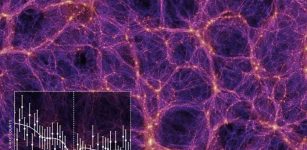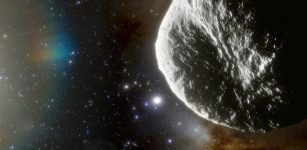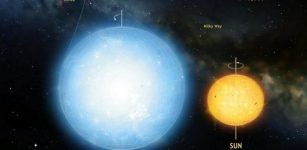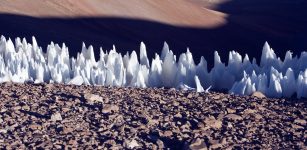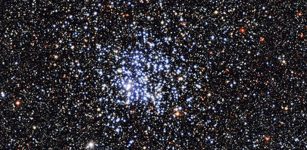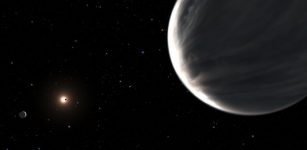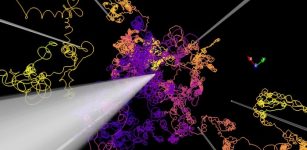‘Galactic Underworld’ – Milky Way’s Graveyard Of Dead Stars Found
Eddie Gonzales Jr. – MessageToEagle.com – The first map of the “galactic underworld”—a chart of the corpses of once massive suns that have since collapsed into black holes and neutron stars—has revealed a graveyard that stretches three times the height of the Milky Way, and that almost a third of the objects have been flung out from the galaxy altogether.
 Point cloud top-down and side-view of the galactic underworld of the Milky Way. Credit: University of Sydney
Point cloud top-down and side-view of the galactic underworld of the Milky Way. Credit: University of Sydney
“These compact remnants of dead stars show a fundamentally different distribution and structure to the visible galaxy,” said David Sweeney, a Ph.D. student at the Sydney Institute for Astronomy at the University of Sydney, and lead author of the paper in the latest issue of Monthly Notices of the Royal Astronomical Society.
“The ‘height’ of the galactic underworld is over three times larger in the Milky Way itself,” he added. “And an amazing 30 percent of objects have been completely ejected from the galaxy.”
Neutron stars and black holes are formed when massive stars—more than eight times larger than our sun—exhaust their fuel and suddenly collapse. This triggers a runaway reaction that blows the outer portions of the star apart in a titanic supernova explosion, while the core keeps compressing in on itself until—depending on its starting mass—it becomes either a neutron star or a black hole.
Color top-down and side-view of the visible Milky Way galaxy. Credit: University of Sydney
In neutron stars, the core is so dense that electrons and protons are forced to combine at the subatomic level into neutrons, squeezing its total mass into a sphere smaller than a city. If the mass of the original star is greater than 25 times our sun’s, that gravity-driven collapse continues, until the core is so dense that not even light can escape. Both types of stellar corpses warp space, time, and matter around them.
Although billions must have been formed since the galaxy was young, these exotic carcasses were flung out into the darkness of interstellar space by the supernova that created them, and hence slipped beyond sight and knowledge of astronomers—until now.
By carefully recreating the full lifecycle of the ancient dead stars, the researchers have constructed the first detailed map showing where their corpses lie.
Color top-down and side-view of the Milky Way’s galactic underworld. Credit: University of Sydney
“One of the problems for finding these ancient objects is that, until now, we had no idea where to look,” said Sydney Institute for Astronomy’s Professor Peter Tuthill, co-author on the paper. “The oldest neutron stars and black holes were created when the galaxy was younger and shaped differently, and then subjected to complex changes spanning billions of years. It has been a major task to model all of this to find them.”
Newly-formed neutron stars and black holes conform to today’s galaxy, so astronomers know where to look. But the oldest neutron stars and black holes are like ghosts still haunting a house demolished long ago, so they are harder to find.
“It was like trying to find the mythical elephant’s graveyard,” said Professor Tuthill, referring to a place where, according to legend, old elephants go to die alone, far from their group. “The bones of these rare massive stars had to be out there, but they seemed to shroud themselves in mystery.”
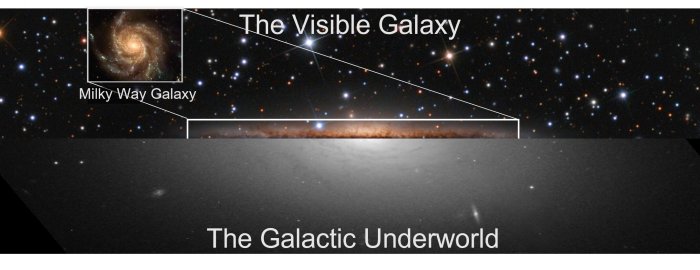 Split view of the visible Milky Way galaxy versus its galactic underworld. Credit: University of Sydney
Split view of the visible Milky Way galaxy versus its galactic underworld. Credit: University of Sydney
Sweeney added that “the hardest problem I had to solve in hunting down their true distribution was to account for the ‘kicks’ they receive in the violent moments of their creation. Supernova explosions are asymmetric, and the remnants are ejected at high speed—up to millions of kilometers per hour—and, even worse, this happens in an unknown and random direction for every object.”
But nothing in the universe sits still for long, so even knowing the likely magnitudes of the explosive kicks was not enough: the researchers had to delve into the depths of cosmic time and reconstruct how they behaved over billions of years.
“It’s a little like in snooker,” said Sweeney. “If you know which direction the ball is hit, and how hard, then you can work out where it will end up. But in space, the objects and speeds are just vastly bigger. Plus, the table’s not flat, so the stellar remnants go on complex orbits threading through the galaxy.”
“Finally, unlike a snooker table, there is no friction—so they never slow down. Almost all the remnants ever formed are still out there, sliding like ghosts through interstellar space.”
The intricate models they built—together with University of Sydney Research Fellow Dr. Sanjib Sharma and Dr. Ryosuke Hirai of Monash University—encoded where the stars were born, where they met their fiery end and their eventual dispersal as the galaxy evolved.
Written by Eddie Gonzales Jr. – MessageToEagle.com Staff




